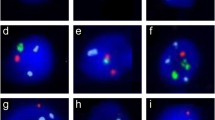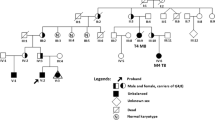Summary
The chromosomal constitution of 1582 human sperm from 30 normal men of proven fertility was investigated after sperm penetration of hamster eggs. A minimum of 30 sperm chromosome complements were analysed per donor so that the distribution and variation in the frequency and type of sperm chromosomal abnormalities could be assessed. The mean frequency of sperm chromosomal abnormalities in individual men was 10.4% (±6.0%) with a range of 0–24.7%. For numerical abnormalities the mean was 4.7% (±2.9%) with a range of 0–10% and for structural abnormalities the mean was 6.2% (±6.0%) with a range of 0–23.1%. The 95% confidence intervals for the mean of an individual male were 0–10.5% for numerical abnormalities, 0–18.2% for structural abnormalities, and 0–22.4% for total abnormalities. There was a significant excess of hypohaploid complements compared with hyperhaploid complements. Since hypohaploid complements could be caused by technical artefact, a conservative estimate of aneuploidy was obtained by doubling the frequency of hyperhaploid sperm, yielding an estimate of 2.4% aneuploidy. The proportion of X-bearing (53%) and Y-bearing (47%) sperm did not differ significantly. These results were compared to the other two large studies of sperm chromosome complements from normal men.
Similar content being viewed by others
References
Angell RR, Aitken RJ, Van Look PFA, Lumsden MA, Templeton AA (1983) Chromosome abnormalities in human embryos after in vitro fertilization. Nature 303:336–338
Boue J, Boue A, Lazar P (1975) Retrospective and prospective epidemiological studies of 1500 karyotyped spontaneous human abortions. Teratology 12:11–26
Bousquet D, Brackett BG (1982) Penetration of zona-free hamster ova as a test to assess fertilizing ability of bull sperm after frozen storage. Theriogenology 17:199–213
Brandriff B, Gordon L, Ashworth L, Watchmaker G, Moore D II, Wyrobek AJ, Carrano AV (1985) Chromosomes of human sperm: variability among normal individuals. Hum Genet 70:18–24
Graham JK, Foote RH, Parrish JJ (1986) Effect of dilauroylphosphatidylcholine on the acrosome reaction and subsequent penetration of bull spermatozoa into zona-free hamster eggs. Biol Reprod 35:425–438
Hanada A, Chang MC (1972) Penetration of zona-free eggs by spermatozoa of different species. Biol Reprod 6:300–309
Hook EB (1980) Prevalence of chromosome abnormalities during human gestation and implications for studies of environmental mutagens. Lancet II:169–172
ISCN (1978) An international system for human cytogenetic nomenclature. Cytogenet Cell Genet 21:309–404
Jacobs PA (1971) Chromosome abnormalities and fertility in man. In: Beatty RA, Gluecksohn-Waelsh S (eds) Proceedings of the International Symposium; the genetics of the spermatozoon. Edinburgh, pp 346–358
Kamiguchi Y, Mikamo K (1986) An improved, efficient method for analysing human sperm chromosomes using zona-free hamster ova. Am J Hum Genet 38:724–740
Martin RH (1983) A detailed method for obtaining preparations of human sperm chromosomes. Cytogenet Cell Genet 35:252–256
Martin RH (1984) Comparison of chromosomal abnormalities in hamster egg and human sperm pronuclei. Biol Reprod 31:819–825
Martin RH, Rademaker AW (1987) The effect of age on the frequency of sperm chromosomal abnormalities in normal men. Am J Hum Genet 41 (in press)
Martin RH, Balkan W, Burns K, Rademaker AW, Lin CC, Rudd NL (1983) The chromosome constitution of 1000 human spermatozoa. Hum Genet 63:305–309
Martin RH, Mahadevan MM, Taylor PJ, Hildebrand K, Long-Simpson L, Peterson D, Yamamoto J, Fleetham J (1986) Chromosomal analysis of unfertilized human oocytes. J Reprod Fertil 78:673–678
Michelmann HW, Mettler L (1985) Cytogenetic investigation on human oocytes and early human embryonic stages. Fertil Steril 43:320–322
Roberts CJ, Lowe CR (1975) Where have all the conceptions gone? Lancet I:498–499
Rudak E, Jacobs PA, Yanagimachi R (1978) Direct analysis of the chromosome constitution of human spermatozoa. Nature 274:911–913
Rudak E, Dor J, Mashiach S, Nebel L, Goldman B (1985) Chromosome analysis of human oocytes and embryos fertilized in vitro. Ann NY Acad Sci 442:476–486
Tarkowski AK (1966) An air drying method for chromosome preparation from mouse eggs. Cytogenetics 5:394–400
Zenzes MT, Belkien L, Bordt J, Kan I, Schneider HPG, Nieschlag E (1985) Cytologic investigation of human in vitro fertilization failures. Fertil Steril 43:883–891
Author information
Authors and Affiliations
Rights and permissions
About this article
Cite this article
Martin, R.H., Rademaker, A.W., Hildebrand, K. et al. Variation in the frequency and type of sperm chromosomal abnormalities among normal men. Hum Genet 77, 108–114 (1987). https://doi.org/10.1007/BF00272374
Received:
Revised:
Issue Date:
DOI: https://doi.org/10.1007/BF00272374




